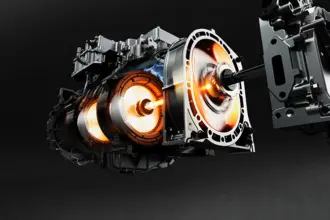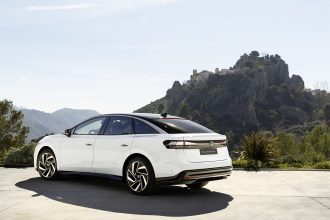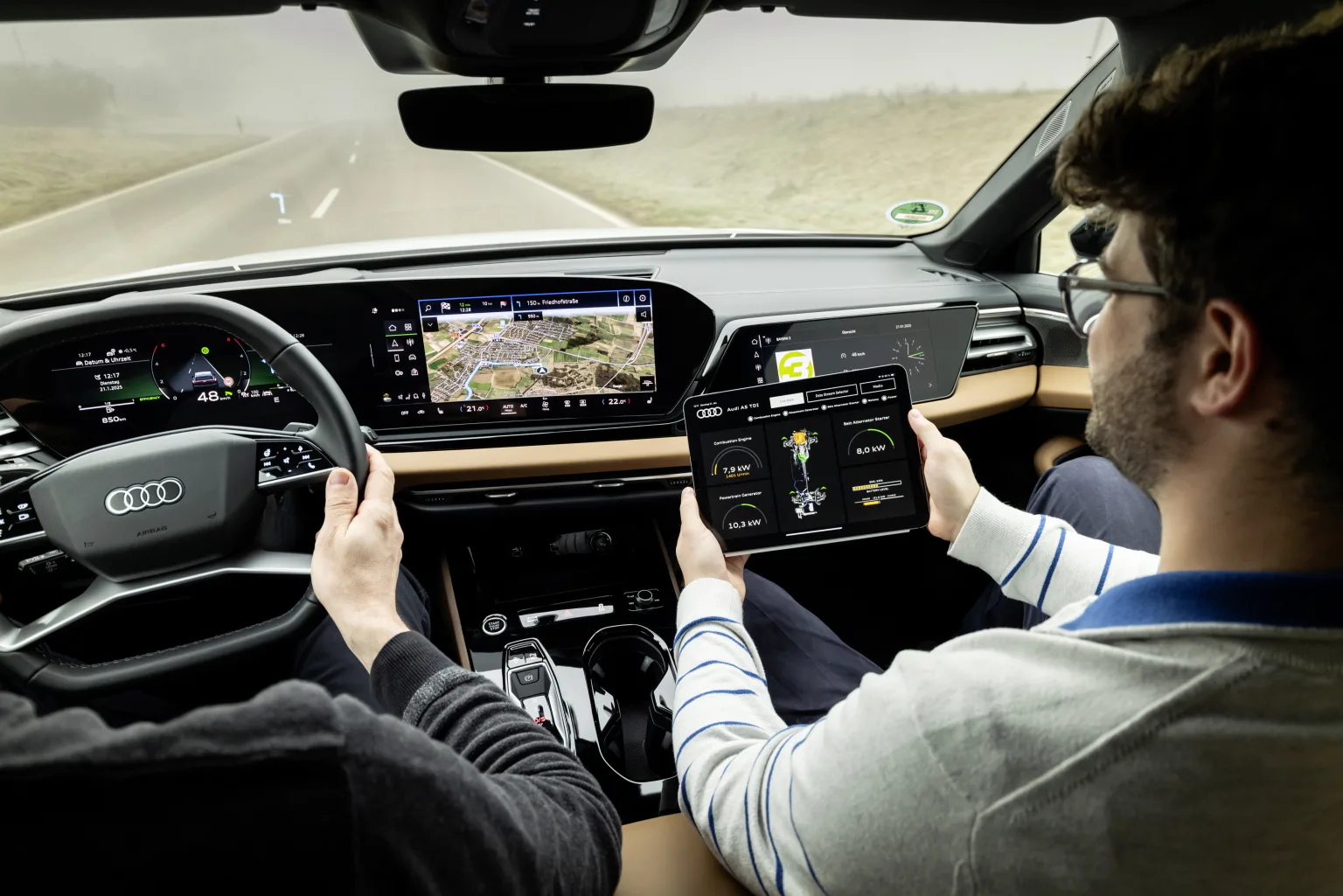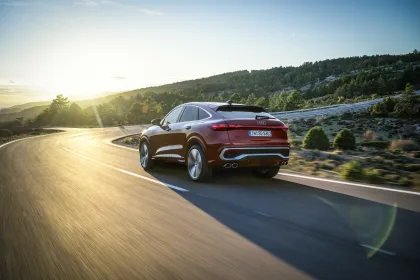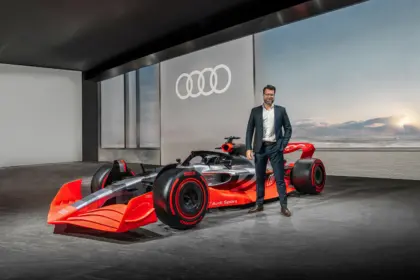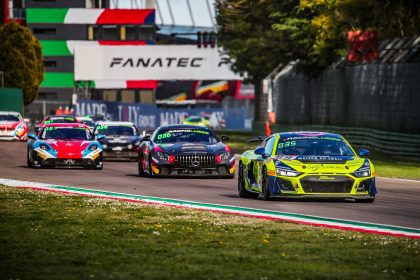- MHEV plus technology with a powertrain generator (PTG) as the electric motor ensures even greater efficiency with partially electric driving
- 48-volt electrical system supports the combustion engine, reduces CO2 emissions, and increases performance as well as driving comfort
- Member of the Audi Board of Management for Technical Development Geoffrey Bouquot: “We are driving forward electrification tailored to customer needs”
With the new A5 and Q5 series built on the Premium Platform Combustion (PPC), Audi has launched its first combustion engines with the new MHEV plus technology. With its unique interplay between the powertrain generator (PTG), belt alternator starter (BAS), and a lithium iron phosphate battery, the 48-volt mild hybrid system supports the combustion engine, reduces carbon emissions, and simultaneously increases performance and agility. The PTG, which can be fully coupled or decoupled, features integrated power electronics and an electric motor that enables partially electric driving. This reduces consumption and makes for an even smoother driving experience.
“With the new MHEV plus technology, we are driving forward electrification in our new combustion-engine vehicles based on the Premium Platform Combustion that is tailored to the needs of our customers,” says Geoffrey Bouquot, Member of the Board of Management for Technical Development at AUDI AG. “This will strengthen our product portfolio of all-electric models, plug-in hybrids, and vehicles with efficient combustion engines.” MHEV plus offers attractive functions such as partially electric driving, electric boosting, and a significant increase in efficiency and comfort. The mild hybrid system in the new Audi A5 and Q5 consists of three main components: the compactly designed new powertrain generator (PTG) with integrated power electronics and a permanently excited synchronous motor (PSM), a 48-volt battery, and the belt alternator starter (BAS).
The components of the 48-volt system are liquid-cooled to achieve optimum operating conditions. The architecture of the MHEV plus system can be integrated into various models with front and quattro drivetrains based on the Premium Platform Combustion (PPC). Situation-specific liquid cooling of the power electronics and the electric motor enables the components to be operated in optimum operating conditions in order to meet power and torque demands in all operating states. The new MHEV plus technology enables purely electric operating states and can also support the combustion engine. The system thereby increases performance and agility while also reducing fuel consumption and CO2 emissions.
For example, in the A5 2.0 TDI (150 kW front/quattro), up to 10 g/km or 0.38 l/100 km can be saved, and in a 3.0 TFSI with V6 engine (270 kW quattro), up to 17 g/km or 0.74 l/100 km (according to the WLTP) savings are possible.
Powertrain generator as an additional powerful drive module
Another major advantage is that the MHEV plus system improves performance and driving comfort. The compact yet powerful electric drive module in the new MHEV plus system is the powertrain generator (PTG). This component also represents the biggest difference to the MHEV technology previously offered by Audi, which works exclusively with a belt alternator starter. The PTG, which is installed in a compact unit with integrated power electronics directly on the output shaft of the transmission, can contribute up to 18 kW (24 PS) of electrical power to the drive. The module enables a maximum torque of 230 Nm at the transmission output, which is already available as drive torque when the vehicle is started. The PTG’s compact transmission operates with a ratio of 3.6:1. MHEV plus utilizes the PTG up to a maximum speed of 140 km/h for maximum efficiency. At higher vehicle speeds, the PTG disengages from the drivetrain via an integrated dog clutch.
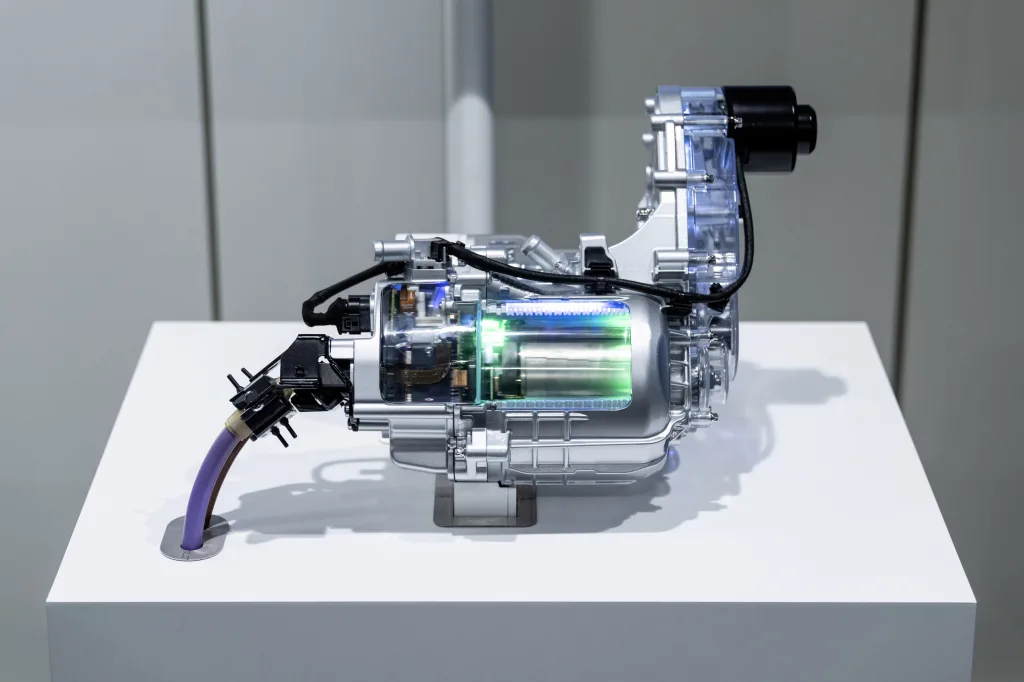
The PTG weighs around 21 kilograms and enables a maximum of 5,550 revolutions per minute on the output shaft. Depending on the vehicle and drive variant, this corresponds to a speed of 130 to 140 km/h.
With minimal modifications to the surrounding parts and components, the required space was created to integrate an electric motor at the transmission output within the existing vehicle tunnel boundaries. The positioning directly behind the gearbox offers several advantages: the 18 kW of drive power or up to 25 kW of power from regenerative braking supplied by the PTG is available directly at the axle output without any further losses. Thanks to this configuration, the PTG can be used in both front-wheel and all-wheel drive vehicles without any modifications and in a modular fashion.
To meet the high comfort requirements of the system, precise control of the torque, current, and speed of the electric motor must be ensured. The operating temperature range extends from minus 40 to plus 75 degrees Celsius. A water jacket surrounds the electric motor and also cools the compact and highly integrated power electronics in the common coolant circuit, which is mounted directly on the electric motor to save space. The high-performance power modules are arranged around the heat sink within the power electronics. The intermediate circuit capacitors are surrounded by the heat sink in a space-saving and thermally optimal way.
Development focused on customer requirements
Audi developed the MHEV plus technology with its sights set on anticipated customer requirements. The conventional drivetrains available with first-generation start-stop or mild hybridization rely on key efficiency components such as engine stop when the vehicle is at a standstill, coasting, freewheeling with the engine off, and 12-volt or 48-volt energy recovery. The main advantages of the increased degree of electrification with the new technology include the added convenience of start-stop operation, emission-free coasting, energy recovery, partially electric driving, for example for electric parking and maneuvering, and increased performance thanks to the electric support of the combustion engine.
This enables the vehicle to be driven purely electrically, leaving the combustion engine switched off for longer, for example when driving slowly in the city, or when traffic is moving slowly on roads outside of the city, or when approaching the next town. Moreover, the vehicle’s start-up response is significantly improved and more spontaneous because the PTG delivers drive torque of up to 230 Nm even at low speeds. This results in noticeably better responsiveness, which translates to a clearly recognizable gain in agility, especially during the first few meters when setting off.
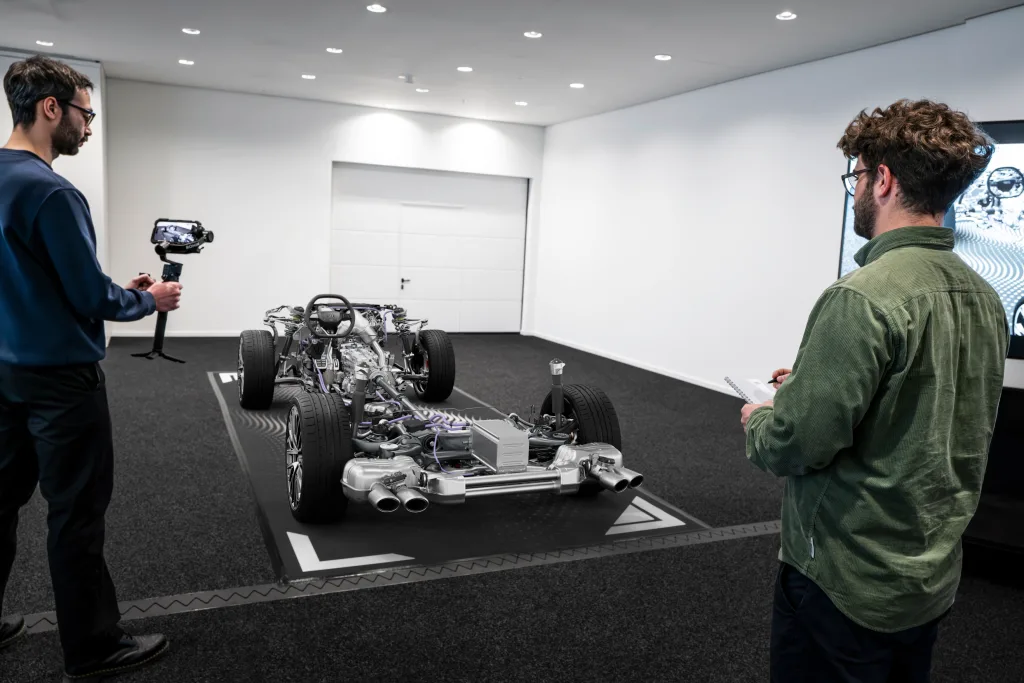
At speeds between 0 and a maximum of 140 km/h, the PTG can support the combustion engine. This means that MHEV plus offers an additional electrical output of up to 18 kW, allowing the combustion engine to operate as efficiently as possible. In this speed range, the PTG can recover up to 25 kW of energy through regenerative braking until shortly before the vehicle comes to a standstill. The integrated blending-capable brake control system ensures pressure-free braking and optimal regenerative braking, usually without using the friction brakes. Thanks to the electric air-conditioning compressor, MHEV plus also enables continuous operation of the air-conditioning system even when the combustion engine is switched off, such as when waiting at a red light.
BAS, lithium-ion battery, and iBRS: an ideal combination
As part of the MHEV plus technology, the belt alternator starter (BAS) is tasked with starting the engine and delivering electrical energy to the battery. The belt drive has acoustic advantages over a pinion starter and achieves a higher starting speed for the combustion engine. This results in better consumption and greater starting comfort. The belt alternator starter can also recover the engine’s energy when it is switched off and places the cylinders in the optimum position for restarting.
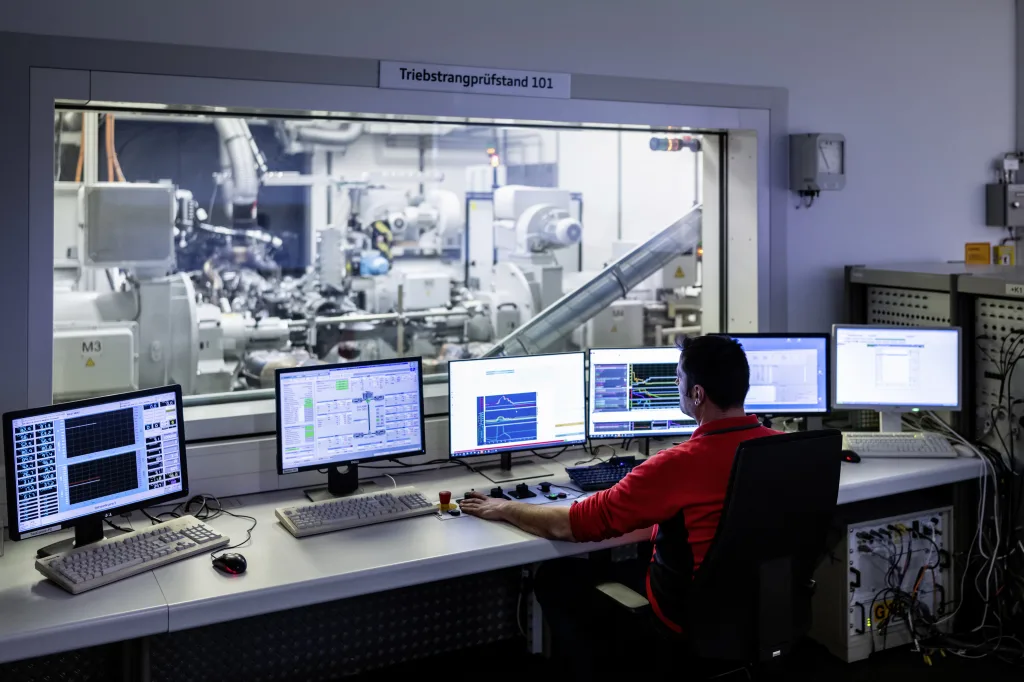
The lithium-ion battery made with lithium iron phosphate (LFP) has a storage capacity of 37 ampere hours, which corresponds to just under 1.7 kWh (gross). Its maximum discharge power is 24 kW. Due to the requirements for availability, power, and torque, the battery is integrated into a low-temperature water-cooling circuit that ensures optimum conditions in the range of 25 to 60 degrees Celsius. This is the first time that Audi is using an LFP battery for its mild hybrid systems.
The integrated brake control system (iBRS) plays an important role in energy recovery. In models with MHEV plus technology, iBRS ensures pressure-free braking and achieves the necessary deceleration through regenerative braking without the use of the mechanical wheel brake. The mechanical brakes are only applied when the brake pedal is depressed more forcefully. This has no effect on the braking feel.
Sophisticated MHEV plus operating strategy
In a hybrid system, the rule of thumb is that a battery charged from 50 to 60 percent works most efficiently, as it can deliver high currents to the electric motor and store high charging currents during energy recovery. The focus of the hybrid system is not on the electric range, but on discharging and recharging the battery in rapid cycles. This enables as much energy as possible to be recovered and quickly reused efficiently for the drive.
With MHEV plus technology, a control software evaluates the operating state of the vehicle for the optimal interaction between the combustion engine, PTG, and BAS. Characteristic values for the optimal use of the two electric motors and desired levels of torque for propulsion or energy recovery are stored for this purpose. The battery charge state is also taken into consideration. The goal is stable operation – and the control system achieves different results depending on the situation. This is because the operating strategy of the additional electric drives is optimized for each combustion engine. The result is the lowest possible consumption without compromising driving dynamics.
The operating strategy takes into account the selected transmission mode and the modulation of the accelerator pedal. For example, in driving mode D, the full additional electric power of maximum 18 kW is only applied by the powertrain generator starting at approximately 80 percent accelerator pedal or kickdown. In driving mode S, the 18 kW of additional power is already available at lower accelerator pedal values. In D, the PTG can be decoupled starting at 85 km/h to prevent electrical losses in the PTG’s electric motor when driving at a constant speed with the combustion engine on highways and roads outside city limits. In S, however, the PTG remains coupled up to its maximum permissible engine speed of 5,550 rpm to enable spontaneous responsiveness at any time.
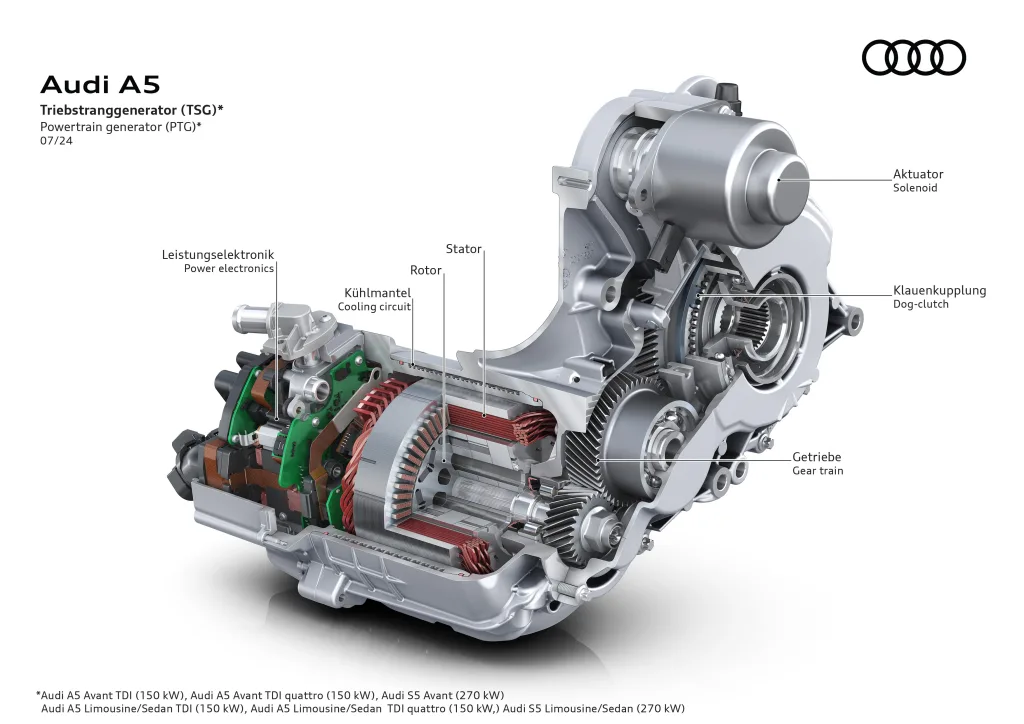
With regard to driving modes D and S, the operating strategy differentiates particularly when it comes to the target SoC (state of charge) of the 48-volt battery. In D, an average SoC of 50 to 55 percent provides the optimal balance for having enough energy available for the electric support of the combustion engine right through to partially electric driving. This SoC is also sufficient to store the high volumes of recovered energy that come from gentle and longer braking phases at traffic lights or when entering towns. In S, a higher target SoC of around 70 percent ensures a higher amount of available energy for the electric support of the combustion engine for more sporty driving. As you would expect, sporty driving involves shorter and more intense braking phases, meaning that there is less energy to recover.
The use of the powertrain generator also offers advantages in terms of driving dynamics, as the additional and immediately available torque means that the vehicle can react more spontaneously to load changes and accelerate more agilely out of corners. The type of load change is also modulated differently in D and S modes to enable more comfortable handling in D and more responsive, dynamic handling in S.
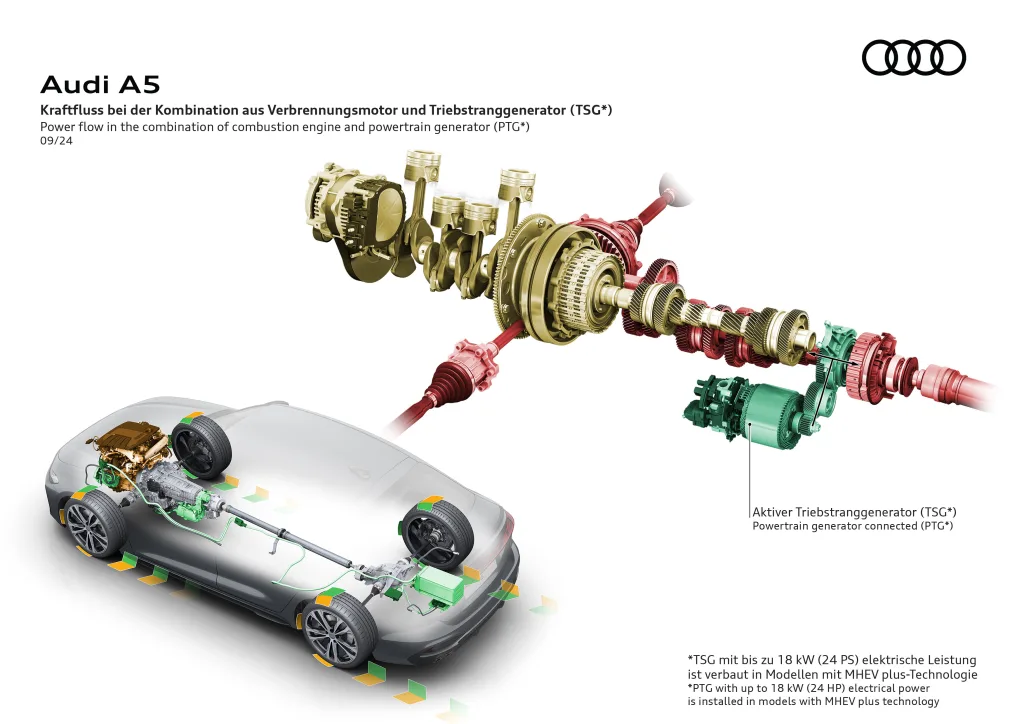
Models with MHEV plus can also run purely electrically, for example when the vehicle is approaching a town, and can then maintain its speed with the help of the PTG. If the power required by the driver or the Adaptive Cruise Control (ACC) exceeds a certain value, the combustion engine starts up and takes over propulsion. The start-up threshold depends on the current SoC of the 48-volt battery and the speed of the vehicle.
If the current SoC is below the target SoC, the combustion engine switches on sooner. On the one hand, this is to avoid consuming additional energy for electric driving and thus lower the SoC even further. On the other hand, the combustion engine can increase the SoC again as needed by means of increased power in conjunction with the BAS and PTG – in other words, recharge the battery. This does not apply to electrically powered maneuvering, creeping along in slow-moving traffic, or parking, which can be maintained at a significantly lower state of charge.
If the current SoC is above the target SoC, the combustion engine switches on later – when there is a slightly higher demand for power. By doing so, the 48-volt battery discharges towards the target SoC so that it can absorb enough energy during future energy-recovery phases. As vehicle speed increases, the threshold for requesting power from the combustion engine is reduced. In simple terms, this means that the higher the speed, the more the combustion engine powers the car.
In combination with whatever is in the tank, the efficiency gains from the powertrain noticeably improve the vehicle’s overall range. This makes vehicles equipped with MHEV plus technology considerably more suitable for long-distance travel and makes those journeys much more comfortable.
This technology will not be offered in the US market due to differing customer needs.

